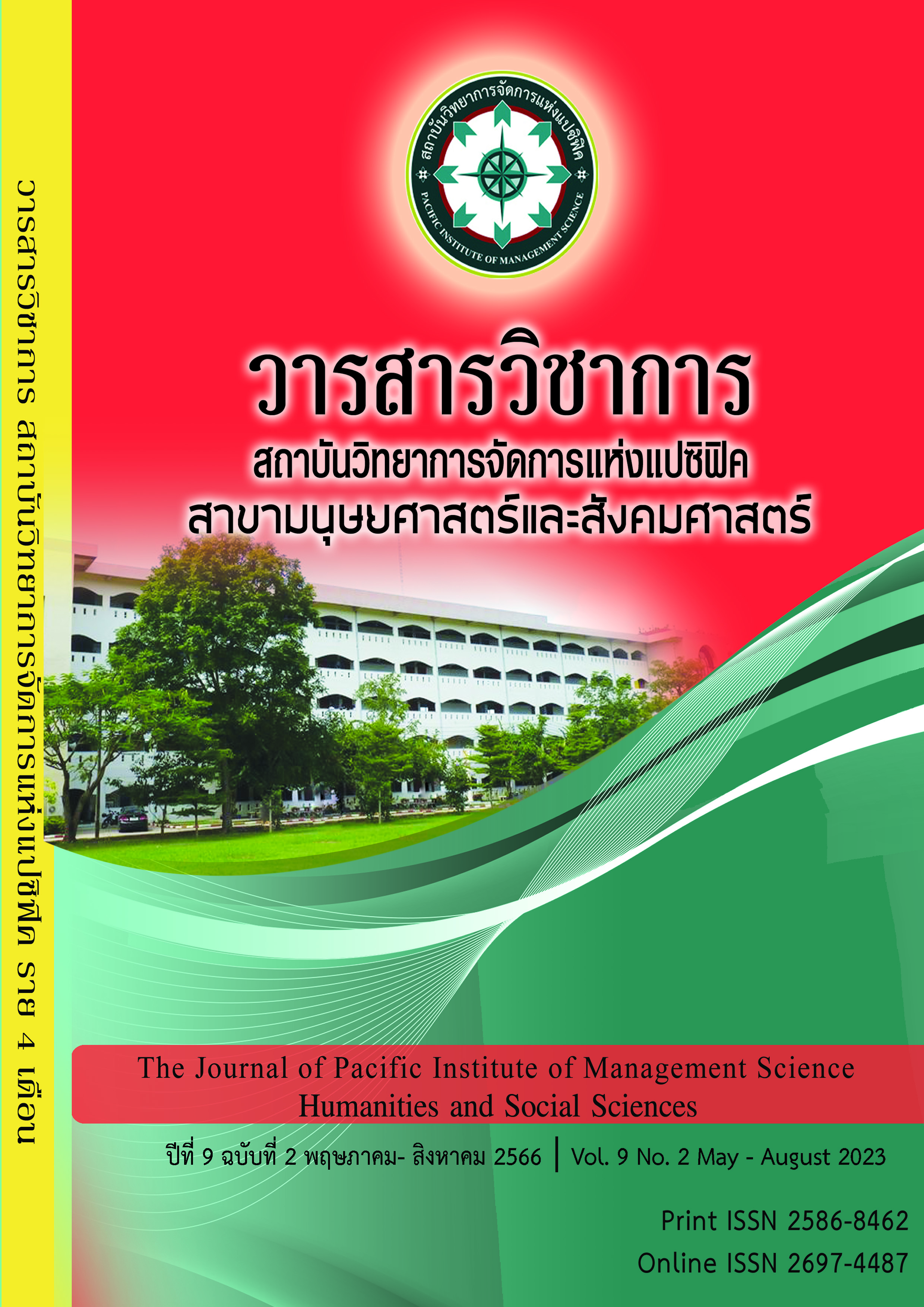Communicative Identity of Health Influencers Affecting Behavioral Changes on Health of Generation Y
Keywords:
identity of influencers, health influencers, behavioral changes of health, generation YAbstract
This research aimed to: 1) study the factors on communicative identity of health influencers; and 2) to study how those identity affecting the behavioral changes on health of generation Y. The study was a quantitative study applying a questionnaire for collecting data from 200 samples who were generation Y, aging from 25 to 42, and continuously followed health issues or contents from health influencers via social media. The statistical tools employed were percentage, mean, factor analysis and structural equation analysis.
The results revealed that: 1) communicative identity of health influencers composed of 5 factors – truthful endorsements, sincerity, expertise, visibility and uniqueness; the CFA was at a good level weighing at ที่ 0.87, 0.85, 0.83, 0.73 and 0.68 with .05 statistical significances; and goodness of fit index (GFI) was χ2 =2.014, df = 3, χ2 /df=0.671, P-Value =0.569, RMSEA = 0.000, GFI = 0.998, AGFI = 0.990, RMR = 0.005, CFI = 1.000, and HOELTER = 1549 which was at the acceptable level. 2) Regarding those identity affecting the behavioral changes on health of generation Y and goodness of fit index (GFI) was χ2 =57.770, df = 30, χ2 /df=1.924, P-Value, RMSEA = 0.048, GFI = 0.973, AGFI = 0.950, RMR = 0.024, CFI = 0.988, and HOELTER= 303 which was also at the acceptable level.
References
Al-Emadi, F.A. and Ben Yahia, I. (2020). Ordinary celebrities related criteria to harvest fame and influence on social media. Journal of Research in Interactive Marketing, Vol. 14 No. 2, pp. 195-213. https://doi.org/10.1108/JRIM-02-2018-0031
Campbell, M. C., & Kirmani, A. (2000). Consumers' use of persuasion knowledge: The effects of accessibility and cognitive capacity on perceptions of an influence agent. Journal of Consumer Research, 27(1), 69-83.
Chaorasameekul, Passaya. (2021). 5 healthy trends of 2021. Retrieved April 19, 2021, from https://thestandard.co/5-healthy-trends-of-2021/
Chinsuporn, Paveena. (2019). Clean Food Micro-Influencer’s Attributions on Instagram, Content Engagement and Purchase Intention of Female First Jobbers. Master of Arts (Communication Arts). Chulalongkorn University. (in Thai)
De Veirman, M., Cauberghe, V. and Hudders, L. (2016). Marketing through Instagram influencers: impact of number of followers and product divergence on brand attitude. International Journal of Advertising, Vol. 36 No. 5, pp. 798-828.
Feungfusakul, Apinya. (2003). Identity. Bangkok: National Research Council of Thailand. (in Thai)
Goodyear, V. A., Boardley, I., Chiou, S.-Y., Fenton, S. A. M., Makopoulou, K., Stathi, A., Wallis, G. A., Veldhuijzen van Zanten, J. J. C. S., & Thompson, J. L. (2021). Social media use informing behaviors related to physical activity, diet and quality of life during COVID-19: a mixed methods study. BMC Public Health, 21(1), 1–14. https://doi.org/10.1186/s12889-021-11398-0
Grid by PEA. (2021). healthy trends of 2021. Retrieved April 19, 2021, from https://www.gridmag.co/healthy-trend-2021/
Influencermarketinghub. (2021). What is an Influencer? – Social Media Influencers. Defined [Updated 2021] Retrieve from ttps://influencermarketinghub.com/what-is-an-influencer/
Izea. (2020). Influencer Tier Guide for Marketers Retrieve from https://izea.com/2020/09/04/ influencer-tier-guide-for-marketers-what-different-levels-of-influencers-can-achieve-for-your-brand/
Kaewpradap, O.(2019). Consumers’ attitude towards YouTube Mega influencer, Macro influencer and Micro influencer in case of cosmetics industry consumers. [Thammasat University]. https://digital.library.tu.ac.th/ tu_dc/frontend/Info/item/dc:175720
Mahasamut, Rataya. (2015).The Effects of Communication Strategies of Online Influencers Toward the Attitudes of Followers. Master of Arts (Communication Arts and Innovation). National Institute of Development Administration. (in Thai)
Morteo, I. (2017). To Clarify the Typification of Influencers: A review of the literature.
Permprayoon, N. (2019). Creative Communication for Creating Personal Identity via Facebook. [Communication Arts, Graduate School, Bangkok University]. http://dspace.bu.ac.th/handle/123456789/4056
Positoning. (2019). First time! Wise sight reveals insights into Thailand's influencer landscape. Not the answer. https://positioningmag.com/1246722
Quan, T.-T., Mai, D.-T. and Tran, T.-D. (2020). CID: Categorical Influencer Detection on microtext-based social media. Online Information Review, Vol. 44 No. 5, pp. 1027-1055. https://doi.org/10.1108/OIR-02-2019-0062
Ryu, E.A. and Han, E. (2021). Social Media Influencer’s Reputation: Developing and Validating a Multidimensional Scale. Sustainability, 13, 631. https://doi.org/10.3390/su13020631
Simon, B. (2004). Identity in modern society: a social psychological perspective. United Kingdom: Blackwell Publishing Ltd.
Štefan Žák and Mária Hasprová. 2020. The Impact of Opinion Leaders on the Consumer Behavior in the Global Digital Environment. Globalization and its Socio-Economic Consequences 2020. https://doi.org/10.1051/shsconf/20219206043
Sukhothai Thammathirat Open University. (2019). Media Studies. 1st ed. Nonthaburi: Sukhothai Thammathirat Open University. (in Thai)
Tellscore. (2021). List of Influencers Winners of Thailand Influencer Awards 2020. Retrieved April 21, 2021, from https://www.thailandinfluencerawards.com/.
Uzunoğlu, E., & Kip, S. M. (2014). Brand communication through digital influencers: everaging blogger engagement. International Journal of Information Management, 34, 592-602.
Downloads
Published
Issue
Section
License
Copyright (c) 2023 Pacific Institute of Management Science

This work is licensed under a Creative Commons Attribution-NonCommercial-NoDerivatives 4.0 International License.
บทความที่ได้รับการตีพิมพ์เป็นลิขสิทธิ์ของ สถาบันวิทยาการจัดการแห่งแปซิฟิค
ข้อความที่ปรากฏในบทความแต่ละเรื่องในวารสารวิชาการเล่มนี้เป็นความคิดเห็นส่วนตัวของผู้เขียนแต่ละท่านไม่เกี่ยวข้องกับสถาบันวิทยาการจัดการแห่งแปซิฟิค และคณาจารย์ท่านอื่นๆในสถาบันฯ แต่อย่างใด ความรับผิดชอบองค์ประกอบทั้งหมดของบทความแต่ละเรื่องเป็นของผู้เขียนแต่ละท่าน หากมีความผิดพลาดใดๆ ผู้เขียนแต่ละท่านจะรับผิดชอบบทความของตนเองแต่ผู้เดียว







